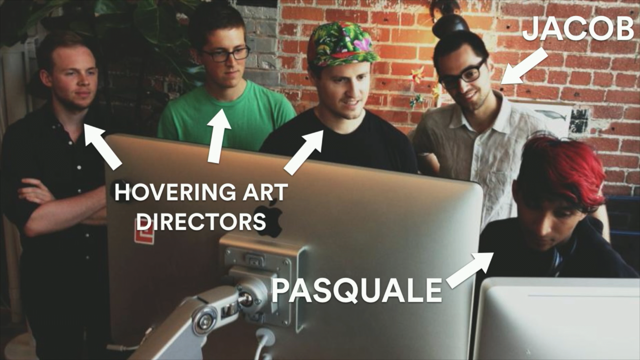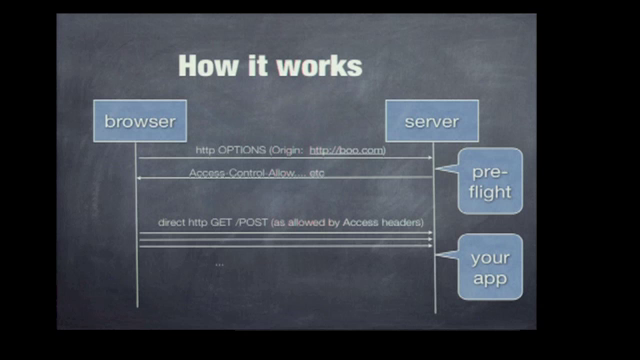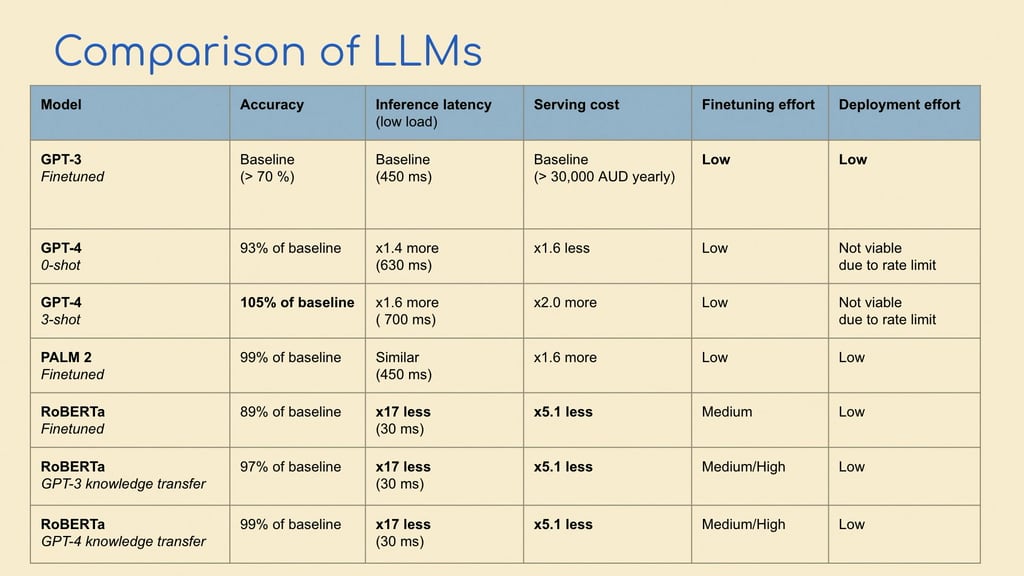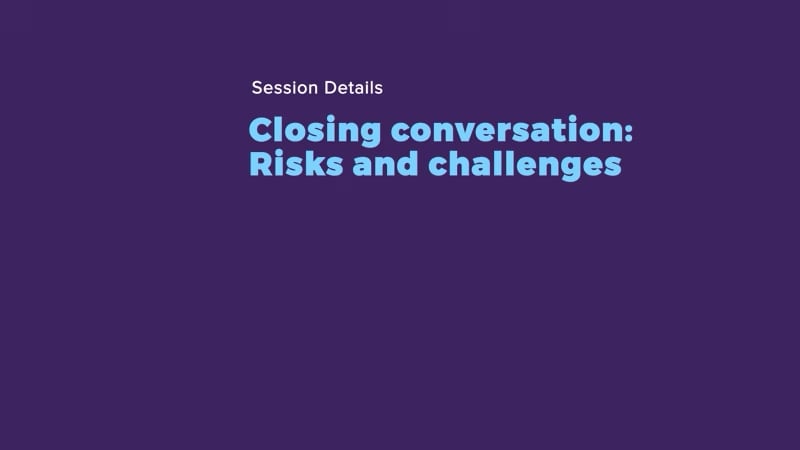Business and Strategy–a conversation
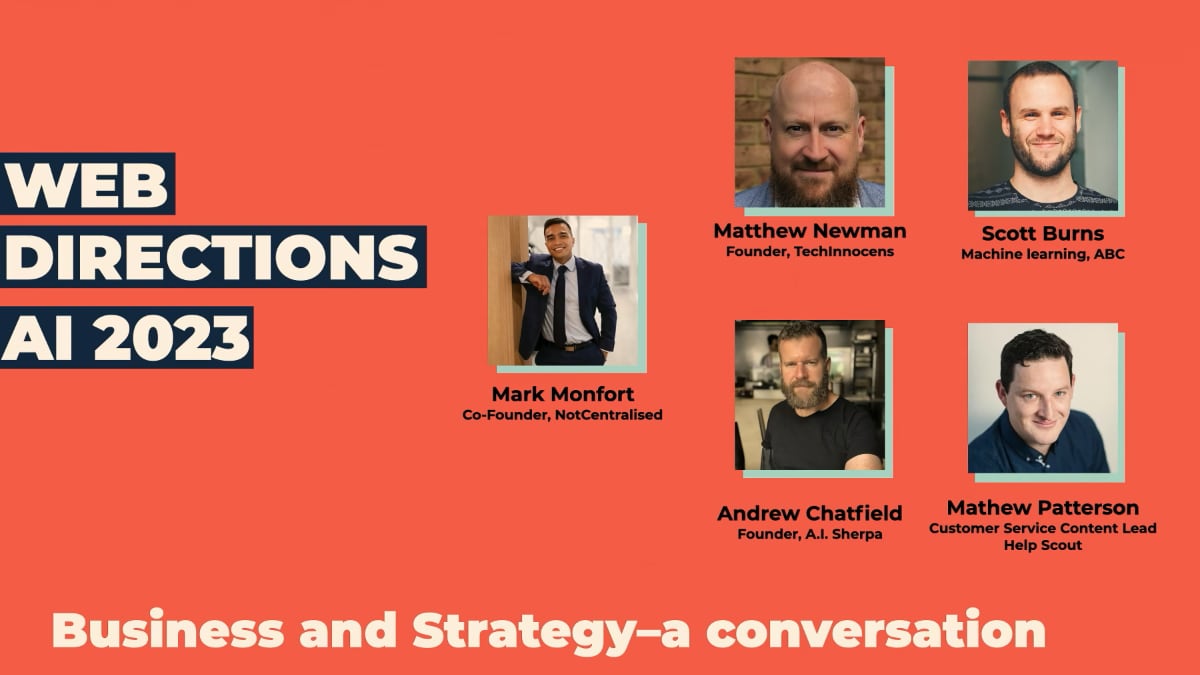
Introduction and Panelist Introductions
Mark Monfort opens the session and invites panelists Mat Patterson, Scott Burns, Matthew Newman, and Andrew Chatfield to introduce themselves. They share their professional backgrounds in customer service, product management, AI, and technology consulting.
AI's Role in Customer Service
The panel discusses the use of AI in customer service. Mat Patterson talks about AI applications in improving online customer support, emphasizing AI's role in enhancing efficiency and customer experience.
Aligning AI with Business Strategy
Matthew Newman addresses how to select appropriate AI solutions that align with a company's strategic direction and risk profile. He emphasizes understanding the technology and its business implications.
Expanding AI and ML Teams
Scott Burns shares his experiences with the challenges of expanding AI and ML teams, focusing on the integration of technology into business and the importance of a human-centered approach.
Product Innovation Through AI
Andrew Chatfield discusses the role of AI in product development, stressing the need for iterative learning and aligning AI features with customer needs and company expertise.
Business Considerations in AI Adoption
The panel explores the key considerations for businesses adopting AI, including cost, infrastructure requirements, and the integration of AI tools into business operations.
AI in Customer Service and Organizational Change
Discussion turns to the need for organizational changes to support AI in customer service, examining AI's impact on customer experience and the cultural shifts required for effective AI integration.
Mark Monfort: I want to hand over to the folks that are here to do a one to two sentence intro on each of them.
Let's start off here, Matt.
Mathew Patterson: Hello.
My name is Mat Patterson.
I am a customer service educator for HelpScout, online customer service software platform, background in web design and, last decade or so talking about how to do better online service through technology.
Scott Burns: Hello.
My name is Scott Burns, aka Burnsy.
The, yeah, so I work at the ABC.
I'm a senior product manager with the machine learning and AI team.
And my background's in product management and design.
And I really If I was to categorize myself, I put my hand up before with Andrew's ecosystem.
I definitely sit between the productizer and the market shapers group.
Matthew Newman: Hi there, morning.
Matthew Newman.
I run TechInnosense.
We're a boutique consultancy.
I spent 25 years helping organizations implement emerging technologies and the past decade that's been, machine learning, AI technologies, and now of course, generative AI.
What do we do?
We help, companies, use this technology in a balanced way.
So when the hype is less, we focus more on the opportunity space and how this technology can help you.
And right now the hype is high.
So we focus rather more on, the risk of use and using the technology responsibly.
Mark Monfort: And Andrew, we know who you are.
Andrew Chatfield: You might recognize me from Mark Monfort: Past talks such as and thank you for setting the scene there.
One of the things that you said was really interesting about being pragmatic in this space.
There's a lot of hype, there's a lot of noise.
And we do get a lot of naysayers and stuff in this space, so I put a question for you in the Discord, so jump to that and feel free.
I guess that the point of the Discord as well is that it's not just the speakers up here answering questions, let's crowdsource this kind of stuff as well and let's continue the conversation.
And by way of background, apart from running the associations, I run a venture studio.
Which is called Not Centralized.
We work in blockchain and AI.
We raise capital for companies.
We also build products in the space as well.
One of our, tools is actually in the RBA's pilot project for an electronic Aussie dollar.
So there's some really interesting stuff going on in both blockchain and AI.
First question will be for Mat.
And these are some specific questions for each of the speakers here.
In what you've, in what ways have you seen SMB companies use AI as part of their customer service interactions, especially what you guys are doing over there.
Mathew Patterson: Yeah, I, I think to Andrew's point earlier, anytime there's a new technology, slashing costs is definitely something that people think about.
And customer service is generally at the top of that list, which I have feelings about.
But, that's happening, right?
There are, there's a certain segment of companies who are currently providing very mediocre support through underpaid and under resourced people, and as soon as it's feasible for them to do that more cheaply with AI, they will absolutely replace those people with equally mediocre AI support.
So that's going to happen, but that's very dull to talk about.
I think they're more interesting, more customer centric companies are using AI already in a couple of different ways.
Firstly, before you even get a support ticket.
If you've ever done any customer support yourself, you will know there is a big chunk of those which are really, people could have answered that themselves if they had found the right document.
The answer's already out there, they just didn't find it for whatever reason.
And so I think there's a huge opportunity for AI there to translate someone's poorly phrased question into something which the knowledge base can actually provide an answer to.
So there are tools that can, that already do that, but basically a better search engine that has a more conversational interface is definitely going to help a lot of companies.
And then you've got support that is, AI that is really about understanding and managing all of that incoming customer service.
And answering it.
So in terms of management, really talking about trying to understand, like, where are all these support questions coming from?
Why have we got questions of which features are the questions mostly about?
Where are we causing those problems to be created that need support?
Categorizing them, tagging them so that you can understand that you can report back to the rest of the business about it.
This is something that can be done now manually.
But it's often the first thing to get dropped when it's really busy.
Or people come up with their own 400 different tags for exactly the same thing.
And having an AI to do that kind of taxonomy can be super helpful.
There's a lot of companies out there already offering that sort of service.
There's sentiment analysis, been around for a long time, which is another form of AI, machine learning, understanding who are the angry people and prioritizing them, either to the top or the bottom, depending on how you feel about angry people.
And then you've got, when you're actually answering the question, is it helping people to maybe suggest an answer to them, have the AI suggest to the human person, here is a potential answer that you could use.
And then helping them to like maybe take four bullet points and expand that into a couple of paragraphs, or to make something slightly less formal or more formal, or to translate it into another language.
All those sorts of tools that are just helping the human person do their job more efficiently.
And to do things maybe in a way that was not feasible before.
I think all these areas, it's already coming, but there's going to be so much more of that.
Lots of interesting ways to create better customer experiences.
Mark Monfort: Interesting.
Does this one work?
Okay.
I guess that one's not on.
That's fine.
I was going to give you my mic, Andrew, but, this one.
Oh, you've got, okay.
Don't worry about it then.
Technology.
Sorry, folks.
No, it's really interesting.
To your point there, if you've got existing expertise, then AI is going to make it more efficient.
And if you're weak in the space, if you're giving poor customer service, I guess we're going to get to poor customer service faster.
Mathew Patterson: Yeah, AI is not magically going to make you care about customer service.
But I think there is an interesting study to show that AI tools are really helpful in getting people up to speed in support.
So there's a lot of research that shows that just having an AI kind of tell you what the answer probably is actually really ramps you up much faster.
Mark Monfort: Interesting.
Your IP out there, folks, is still very important.
Matthew Newman, we're going to jump to you.
Given your role in helping, businesses implement emerging technologies, how do you identify the right AI solutions that will align with the company's strategic direction and I guess their risk profile?
Matthew Newman: Yeah, the two very important, aspects.
I think it's clear that we're going through this hype cycle at the moment.
There's a lot of, a lot of voices offering magic, offering, solutions that, promise everything.
And it's a little bit tricky as organizations to, to navigate that space and understand whether it's from the foundation models.
How can we use generative AI?
Through to using third party point solutions, things are higher tech, where they're offering kind of magic solutions -you'll get the best employees you've ever had guaranteed, through to organizations that are actually using their data to, to do something internally or to offer better products, differentiate.
The way that I think of it for organizations, and I explain it is that, because it's such a fast moving space, you need to marry the technology with the understanding of your organization, otherwise you're going to be led by solutions looking for problems, so you do need to have the people who understand the business, who understands the kind of challenges they're facing, who understand the opportunities on board.
But this is such a fast moving technology and it's, it is complex.
So it can be really difficult to navigate that and understand, okay, what can we do with it?
What should we do with it?
What maybe not do that?
So the way I picture it is as a box to play in.
And that box has got four sides.
And the first side then is to understand your opportunity space and understanding your strategy, understanding your competitors, understanding where the competitors are using this technology, whether you have appetite to use this internally or whether, as you said, it's the "slashers", I think you call them, nice name, or whether it's something you're going to go to market with.
And, the kind of opposing side to that, the other side of the envelope is your risk space.
This is going to be very personal for all organizations.
There is no standard answer.
It's dependent on many things.
It's dependent on, okay, what you stand for as an organization.
What kind of services do you deliver.
But also, your, the market you're delivering into, the expectations of the, your customers, the expectations of society generally, what your, you know, that, that social contract is you have with society.
Those two kind of form the sidewalls.
And as with all of these boundaries, the crisper you can get those, the better you can understand those, and the better you can translate those into, measures and into, specific, guidelines for your organization, the wider the organization can play.
And at the top and bottom then, I see that the technology forms that ceiling.
And again, the better your organization understands that technology, the less mysterious it is, the better they can have conversations about what it can and can't do, the better your data science team are actually talking with the business leads and saying, this is the limitations.
This is the trade offs.
This is what we can expect to happen.
And this is what can't happen.
The closer your organization can play to that limit.
And the final one is a kind of a flaw, which is how able are your organization to execute on this?
And there's two main things that I see there.
And that's the capability of the organization themselves, how they understand what the technology does, etc., and how they can translate that into business need.
But importantly also, for the, for organizations that are using their own data, the quality of that data, the ability to actually use it, and to understand where it's from, and to understand, where it's appropriate to use, etc.
That probably boring.
Probably not the most interesting thing when generative AI, but sadly an absolute, foundation for your success in using the technology.
Mark Monfort: I would love to hear where a business has said that because of this mid journey image, we've been able to generate X amount of revenue.
And I think it'll happen.
So it's, I think Matthew Newman: this one is pretty cool.
I'm impressed by those.
Andrew Chatfield: By the end of today, I might have, some revenue for you.
Mark Monfort: We'll talk.
Speaking of business, Scott over at the ABC, you've been growing the AI and ML team over there.
What kind of challenges have you faced in doing that and what are some of the solutions that you've come up with?
Scott Burns: Yeah, a bit of context here for the ABC, I know that.
Whenever I've told people, oh, AI, machine learning at the ABC, they go, what?
Really?
ABC?
Because of the legacy that the ABC holds and the history, it's somewhat confusing and baffles people that, wow, they're actually dabbling in that space.
Now, the fact is that we have been dabbling for quite a long time and I've been incredibly lucky to join a team where, of toolmakers, that have been doing this for years, not ever since last November when ChatGPT was launched and everyone went 'oh maybe we should do something about this'..
We've been on this journey for a lot longer than probably what the hype and the media have been able to communicate.
Now, with that, we've been able to really address some of the challenges that comes with integrating this technology into an organization.
Now, that's not simple.
It's very complex.
The technology is complex and the way it is incorporated into a business is almost inflates that complexity even more from two key aspects that we've identified.
From the backend infrastructure and how you're managing that data, how you're managing these services, and how you're essentially laying a groundwork and foundation for this thing to progress into a more meaningful way.
And the second and the most biggest one, and Andrew, you mentioned this in your talk, is that the pace of how this change is being adopted and integrated is set by the humans, not by the machines.
And those humans are the different teams, the different people, the different financial structures, the different, people that need to be holding the reins of these, this amazing toolkit that's now available, and that's really complex spaces.
All of a sudden, there's not about a team or a core group in an organization that worries and thinks about this technology.
It must be collaborative, has to be collaborative.
Now that takes time.
Any product that you're developing that is powered by AI or is augmented by AI, it's going to take time.
And just because it is progressing, the technology is progressing so quickly doesn't mean the humans that surround that technology, use it, consume it, adopt it, are going to move at that pace as well.
And that's a big part of my role and I guess how we've been able to do this is very much from a cultural perspective, not necessarily from, Hey, here's a new process, here's a new framework, especially in an organization like the ABC with such rich integrity, very strong brand trust with the Australian public.
The ways in which you conduct an experiment with these tools needs to be very much within a framework of safety and being risk aware, having your security measures very watertight and being able to communicate that to the rest of the business.
That's been a lot of the big, what's holding us back from that growth at the moment.
But it's simple.
It's not, there's no silver bullet here.
It just goes back to same first principles of change management, really, is put people first.
The technology is a strong enabler.
But if you're not considering the people that this is touching, and the people that this is affecting, and the anxieties that's going to come with, a tremendous amount of anxieties, and I'm really lucky to work with a colleague, Anna, who's going to be speaking later, and we definitely see ourselves as driving and guiding that change.
And that doesn't mean we need to move at breakneck speed or we need to worry about oh my god it's going to change so let's catch up.
It's taking it slow, taking it easy and being able to empathize with the people that you need to rely upon to make this tool useful.
You can make it as useful and as great as you want but if it's not being adopted in the right way, it's going to sit on the shelf and not get used.
So yeah, I think that would be the way in which we're approaching that.
Mark Monfort: Really interesting.
There's, we see a lot of that with technology because it just hasn't been culturally brought into the business well enough, even though it has all this value.
I saw it in data science and analytics tools, for example.
And I think we're going to quickly move from a place where businesses are curious and they want to or they're looking into it to needing to be there to be able to compete.
You will not be able to compete without AI in the future and I think it's going to happen sooner than we think.
Speaking of products, Andrew, back to you, as a former CPO and all about products, how do you manage the balance between AI and innovation when it comes to the functional integrity of a product or a service that you're building?
What do you think about that?
Andrew Chatfield: What a great question, Mark.
Well done.
Yeah, it's not like it was scripted by ChatGPT.
And I don't know if you were listening carefully, but between the lines, I think Burnsy pretty much revealed that Michael Rowland from ABC Breakfast is AI.
And I've suspected that for a long time.
Knew that?
Your first product's gonna be shit.
It's really easy for a lot of people to use ChatGPT and then make one jump and say, we need a chatbot.
There's a journey that you go on just like always to iterate and actually find the utility and find the product.
And again, that happens at human scale.
You've got technology that will go extremely quickly, but the mistake that I think a lot of people are making is thinking that the journey is very short from taking, ChatGPT or some other generative AI product and then having something that anyone will want soon.
I mentioned in my presentation earlier that I think there's a bunch of features that have been rushed to market in this first half to get the press and I think, that's going to cause a bit of a hype deflation cycle, Gartner talks about it, the valley of discontent, or something like that, where a lot of promises are being made, we see all those Twitter threads about, graphic designers, RIP, I really don't think there is going to be a wave of mortality through the graphic design industry, I think, tools like Midjourney and stuff are great for, illuminating a concept, which can then be taken through to production, and I think in that sense it makes existing experts better, but really, if you're thinking about taking a journey and building AI features, just expect that your first few goes at it are going to suck and you're going to learn a lot.
And Mark, you said the key word earlier, which is IP.
You have expertise, you know your customers, you know your problem space, and what will happen as you go on that journey with generative AI is that you'll start to encode what you know and what you've learned into your features.
And that's the value.
The technology gives you something that you can do better than you could do before.
But the real value that you create is that journey that you go on of discovery and learning with your customers.
Focus on that.
Mark Monfort: Very cool.
Hands up here who wants their business to be leveraging AI more than they are already?
I would have expected more, come on.
But no, it's good to be careful and pragmatic.
We're going to get to a set of audience questions.
Sorry, we're going to get to a set of general questions.
I've seen some audience questions coming through on the Discord, please continue, we will get to those.
But, general question, I'm just going to throw it up.
Whoever wants to pick it up, can do it.
Even if you want to type into your phones and get ChatGPT to answer these questions, we are totally fine with that, we are accepting of all, man and robot.
But, for everyone, what do you guys think of, what do you think you need to be aware of as you leverage AI technology in your business?
Mid sized, large, small, whatever.
What are some of the things that people just need to be aware of?
Let's just say if they're getting started.
Any takers?
Mathew Patterson: I can just throw in there one thing that, especially for a smaller business, it might be way more expensive than you think it's going to be.
Mark Monfort: Talking money or time?
Mathew Patterson: Both, but mostly money.
In terms of, you use ChatGPT for free and it seems amazing, and then if you look at how much it's going to cost you to implement that in a product that other people can spend your money every time they press a button, you need to think about that.
Mark Monfort: 30 Aussie dollars is pretty cheap when you look at how much it costs you to use GPT for OpenAI.
In terms of the way that I've been using it anyway, so yeah.
Scott Burns: Echo that, that's a really interesting thing because even in any organization, the people behind these tools and that have established this, they know the value and they will charge you for it, it's that simple.
I'd say another thing to really consider is, and often, a barrier to scale is really like your back end systems and your infrastructure around if you choose to do this to get that into gear and to be really thinking about that because it's only, these tools are only as good as how you could scale them, depending upon how your product performs.
And if you don't have the foundation and the infrastructure to scale this in a meaningful way, and to make sure that you're monitoring it, make sure that you're aware of how it's happening, these, the risk of these things becoming a black box and you turn it on and then stuff happens you didn't expect, it's very real.
And in order to have that kind of confidence in taking this into your consumer, taking this to your user, you need to have quite a lot of investment in place to make sure that you're doing it in a responsible way.
And that's no easy step.
So that's a first kind of Okay, what do we do about this?
And it takes, a really, hybrid team of both product, but way more importantly it is the tool makers, yes, but I'm almost thinking like tool advisors, people that are really, they may not be crafting these tools, but they really know them in an intimate level.
They know the research, they know what's happening, and they know where it's going, and they can really try and set up people to think about that long term, strategic view of your infrastructure to make sure that as the technology develops, you're not having to rebuild, re architect, re configure and ultimately maybe lose that return on that investment that you're making up front.
Tool Mark Monfort: advisors, that's a great one.
We saw prompt engineers as a new thing, might be translators, there might be some cool new jobs like that, but certainly needed.
Matthew?
Matthew Newman: I think That, that idea of understanding the tools is really important, but also for, I think, medium sized organizations, they're gonna, they're gonna have two kind of experiences with this technology.
One is the generative AI, these foundational models, and they're getting a lot of attention.
But what we've seen over the past 12 to 24 months is, the productizers, I think you call them.
These kind of point solutions are gonna be the experience a lot of medium sized companies have for this technology.
And I I got two messages.
One, one to the companies who are using this, you need to get yourself into a position where you can have a kind of a grownup conversation with the tool producer.
If you don't understand how it works, you can be sold snake oil, or you have decisions that you probably would have wanted to take on how, the kind of tools your organization has, how it performs, et cetera, that there'll be taken for you by the third party.
And I guess.
On the other side, I'd ask the productizers of which there were many, I think, put their hand up, please do ensure that the customers you sell, I'm fully aware that you need to make that pitch and you need to get your voice heard in an extremely crowded market, but please do be sure that the customers you're selling to understand what they're buying and can have you know, good, strong conversations about the decisions that maybe you've already taken on their behalf about how this model performs, the risks involved, the kind of trade offs, where you landed on those, and that they can actually understand how you've made those decisions on how the product should work and what risks you're exposing them to.
Mark Monfort: I think that's where, interestingly, side note, but blockchain technology and zero knowledge proofs, if you haven't heard of that before.
Is what helps provide that kind of transparency so that if you're in healthcare or something with sensitive data that's being used to train models, that's where we can, trust and verify that the information is as it is for the model.
But snake or GPT sounds like a really interesting project like, you build a bot that gives you bad advice, right?
And so if anyone wants to play around with something like that, I might make something later.
Over to you Andrew, what do you think about that, this kind of like question, what are your thoughts?
Andrew Chatfield: Which question?
Mark Monfort: The question on SNAKE or GPT, no, the question on, how, what businesses need to be aware of if they're just starting to, think about leveraging, whether they're mid sized, whatever size they are.
Andrew Chatfield: Yeah, I'm picking up on a couple of things that my co presenters have mentioned.
One about costs so I observed interesting with interest that Microsoft released pricing for its new Office 365 co pilot product, which was very widely anticipated.
The way that I think about that, ChatGPT kind of got there first and created this new pool of demand.
Everyone wants to be able to search their own documents.
So we knew that Box, Google Workspace, Office 365 would have products and they announced them more or less instantly.
But then the question was, what would they cost?
Something I've been fascinated by is this idea of a commodity trap where all of the major software vendors need to add AI features into their products, but none of them will be able to charge for it.
Because it'll just be table stakes.
Something like the all you can eat super everything O365 license for an enterprise in US dollars is something like 30 per user per month.
They just announced their pricing for Copilot as being another 30.
For an enterprise customer with thousands of users, are they going to double their O365 bill to get the Copilot?
Interesting, we'll see.
For a very small business, so the other end of the spectrum, the Microsoft license is something like 14, but the O365 copilot license is still 30.
So will a small business pay triple to get copilot?
We'll see.
And then the other kind of interesting thing on that is, a few weeks back, OpenAI halved the cost of some of its APIs.
So it doesn't really matter which ones or whatever, but the trend like we saw with cloud when it came out originally with AWS, and then Google, and, Microsoft came into the game as well, is we've seen a long term downtrend in the costs of the basic services, and then just more and more interesting and higher value services come out over time.
I think that's what we'll see in this space as well.
I don't think it requires sort of genius level anticipation to, to figure that out.
So yeah, it's really expensive and it depends exactly what your engagement order with customers is.
We'll see how that plays out, but you can expect that whatever you're doing now will cost less next year.
What I'm hoping is that lots of you will have a business model where you're comparing what you're charging a customer with the cost of them hiring a full time employee.
Because then the math starts to look a lot better.
It's really hard to like, spend a lot on API calls for someone on a 150k salary.
That's where it's going, I think.
Mark Monfort: We'll be okay for now until we have businesses like the businesses that have a bot CEO, a GPT CEO.
It'll be harder to sell, you'll have to sell a whole heap more features if they've already got a whole heap of chat GPT staff.
It's not there yet.
But, speaking of all this, the, because it is the hype wave, I saw this in blockchain.
You get a lot of shysters, you get a lot of folks purporting to be experts in this space and, they wear the nice suits and stuff like that.
Not Andrew.
But, you, we're seeing it here, right?
I can't turn on my LinkedIn or my Facebook page without another, Hey, I'm gonna help your business do AI automation.
I'm gonna document my journey of making a crap load of money in this space.
Great!
I think it can work for some.
Obviously, if everyone's in it and it's a crowded market, it's hard.
But what does the panel think about, how businesses are meant to spot when this is such a new thing, like how are we meant to spot when there is that bad advice that is out there that could potentially lead you to wasting money on a demo or a POC or you know you're trying to fast fail but you've got limited resource and if you choose the wrong horse obviously the goal is to fail fast, but you want to do it with the right kind of people so you learn proper lessons.
What do you guys think about that?
How do we spot that as businesses?
Anyone?
Scott Burns: I think it goes back to, the way we work anyway.
Those tool advisors, those kind of real people in the conversation.
Because the snake oil, side of things, it's very real.
If you just look at it from a market perspective, AI is not new.
Within the market, especially if you're looking at those first moves within your business to be a slasher and cut costs, those slashing mechanisms in AI, well and truly were in the market before chatGPT became very prevalent.
But the thing to be wary of is to know that a lot of those models and a lot of those products that you could do to do that slashing are very old in relation to how AI is moving and there's going to be a vast wave of people and businesses looking to still get a return on the investment they made 5 years ago into these AI models.
And they are still going to push that product to people and leverage this hype, which is, I guess, more latent technology versus the more recent ones that are more reliable or things that you could place your money behind, is to have those tool advisors and those people that are really deep in the technology to be able to say, yeah, nah, these guys have been doing this for too long and they're actually trying to push a product to you that isn't up to date or is going to essentially keep you back, not move you forward in a meaningful way.
Definitely, that, dropping in your LinkedIn emails.
Thick and fast, especially someone like the ABC or people who are just really looking for vendors and people to partner with us.
And so yeah, we definitely, everyone we look through, it's almost like a real quick triage to be like, yeah, no, they're not serious or this isn't a, this isn't probably up to par in terms of what the latest technology can offer.
Matthew Newman: I'm going to pick up on a point you made earlier.
It's a very important one that the technology often isn't the limiting factor in the speed to market.
It's the humans.
I would recommend that any company that you decide to partner with needs to know your business and needs to know you, as an organization and the kind of unique pain points that you're experiencing.
Companies that can solve everything across all verticals, if they're not listed, they're probably not gonna be very successful at solving the specific problems of, multiple different verticals.
So I would, strongly recommend if it looks like it's a, we can do everything for anybody, then it's probably one to steer clear of, and it is that understanding of how you operate as a business, the market you operate in, what your unique constraints are.
That's half the package.
The technology is great and it's important and it needs to be there and it needs to be a great product.
But the ability for that company to actually help you to implement, to help you to understand, the path you need to take that will, one, it pays dividends cause you're actually more likely to be successful, but also it demonstrates that they know their product, they know what they're solving for, and they're not just chucking tech out the door looking for problems.
Mark Monfort: Matt or Andrew?
Mathew Patterson: Yeah, I think, specificity is what you're looking for.
It's easy to sell the big picture of the AI tool that can solve lots of problems, but if they can't tell you specifically what it's going to do in your company, then you're never going to be able to implement it properly.
And then to do that, you need to also understand, what is your actual job that you're trying to do?
At HelpScout, people are not coming to use HelpScout because they want to get really good at managing emails.
They want to help their customers in some way, help their customers do something.
And so that's our job is to help them do that.
And so any sort of AI that we're implementing, we want to think about, how is it actually going to help us do that thing that we're trying to do better?
So someone's going to sell me on how their AI tool is going to do it.
That's the question they're going to have to help me answer too.
So that's what I'd be looking for.
Andrew Chatfield: I think there's one other interesting aspect of this new wave of technology.
And it takes me back to the mid 90s, which is, now I'm so old, all of my old anecdotes are coming out, but, one of the things about programming for the internet, so learning HTML, was that it was extremely accessible.
Anyone could open up Notepad and, read a bit of a guide and you'd have a, your first page.
And that meant that even if you weren't going to be a career web designer or something, you at least got how this thing got there.
What a web page was and basically how it worked.
And I think we all have that with ChatGPT.
I think everyone in this room should be a prompt engineer.
I think we've got a session after lunch which goes into that a little bit and also Paul's going to be talking about how large language models work.
We all have the ability to be able to try stuff out and understand what's going on before we buy a product or engage someone to do the production version.
And I think we should all feel like that, that, that's something that's available to us.
Like we can go and really get this stuff in a way that a lot of maybe data science and stuff happened before where you it was a bit of a black box.
You got a bunch of data scientists coming in and do cool stuff, but really if they started talking to you over a coffee, you might have to make an excuse about some meeting, important meeting you had to get to, right?
There is an accessibility here that's different this time around, and I think everyone should take advantage of that.
Mark Monfort: We can get ChatGPT to explain it to us like a five year old.
Yeah.
So it's all fine.
But, we've got some questions here from the audience, so thank you for sending those through.
I'll get to one of them.
The rest, the crowd and the people on this panel can answer afterwards during the other talks, or later in the day, listen to the talks, folks.
So first question from the audience is, many of the customer services use cases we've seen feel like they're about a race to the bottom.
Because customer service is often seen as a cost to the business.
Do you guys see the need for broader organizational change here to support this transition with the technologies?
Does this need to apply to broader parts of the business too as we start thinking about AI assistance to humans?
Great question.
Thoughts?
Mathew Patterson: Yes, that's the answer.
Absolutely, it's not really a technological problem, it's a cultural problem.
If your leadership doesn't particularly care about customer service, then yeah, you can use these tools to drive costs down even lower, and that has been a long term trend in customer service.
But maybe the one thing that will help us here is that once everybody can use AI and you get the same kind of generic level of kind of crappy service.
It's, you can't get any cheaper once a computer's doing it.
And there will be some need to differentiate.
So I think the smarter businesses and the smarter leaders are going to start thinking about, having that human interaction is now worth more than it was before.
Because more and more people have cut it out, and so then you're going to have to start figuring out, how do we introduce people in a useful way, in a way that's going to add value to the conversation.
The more customer centric businesses are going to be ahead of that curve, and they're going to think about, how can we, they're still going to have to drive down costs because we're still going to be competitive.
But how can we use AI to maybe not hire new people, but to make these people we already have way more effective to be able to scale them up, in terms of their skills and spread that out, more cost efficiently than we could do before this technology existed.
Matthew Newman: I think, inevitably, cost reduction, removing cost is such a, simpler thing to envisage for an organisation.
it's change management, they call it the burning platform.
That's a really simple way.
We scare everyone to, we've got to change or we've got problems.
Identify pain points.
It's easier to identify pain points and opportunities, especially with a technology that's not particularly familiar to people.
Okay.
Everyone uses chat GPT, but they don't really know how it works.
And so the, it's a more difficult process and exercise to actually think what's possible than what pain points can we reduce.
Inevitably, when an organization says, okay, we have to innovate, what's the first thing they do?
It's how can we get rid of some pain points, money reduction, etc.
I think, what I said earlier about that kind of box in which you can operate, it's important.
It's, the initial sort of approach to AI has been very much, especially around risk, to have kind of a board, an ethics board or something, making decisions on what can and cannot happen.
And, very removed from the organization.
I think we, we had that with the internet at the beginning, where if you go to a company and say, where's the internet happening?
They say down the corridor on the left, and in that room, there's internet things.
That's laughable now, but at the time it was yeah, we, what do I need to do with the internet?
That's the internet, guys.
I do marketing.
And I think this is a really similar sort of change in thinking that people need to have with AI as well.
And the better you can define those boundaries of what do we have as our goals as an organization, what are our constraints, where are our boundaries, building people's ability to understand the technology, and also putting in place those foundations so that people can actually, depend on the systems and the data, et cetera, that opens up that box to allow people to experiment and to allow people to see what's possible.
And if you can't open that box, if it's still fuzzy, you're going to go for the low hanging fruit.
You're going to go for the easy stuff.
Mark Monfort: Burnsie or Andrew?
Scott Burns: I was gonna, I was to build on both of those, but something that we think about a lot and really make sure that we're pushing for within decision making circles.
ABC is quite a large organisation, so we're not really, we don't have the luxury of moving as quickly as probably we'd like to, but that's a part and parcel with the benefits of such a large organisation being as much as we need to be aligning quite a lot of people on the shared values that we have.
And so we need to be values led with how we're adopting or thinking about these types of technologies.
And if it's a trade off between, cutting the, or slashing, the costs, or thinking about the knock on effects that might have on staff, or thinking about the knock on effects that might have on the audience, user, consumer, all of those decision points need to be values based because you not only are you going to need to do that and think about how you implement it, but you need to culturally think about how that needs to be integrated across the organization.
And if you don't have a good, solid base for your values and why in which you're making this decision, it will go down like a lead brick.
And I've been involved in those discussions.
I've been involved in those workshops where we're considering certain things and the journalists of the ABC are the first ones to knock it down.
And that's really great.
Because I think they're the ones holding people accountable, holding those values true to an organization like the ABC.
Now you don't need to be a big public broadcaster to think values and to put that to the test.
Every organization should be values based.
I say should, should's not the best word to use, but we're, in our, at least in the way we work and I work, that is a very strong principle to hold yourself to and then think about what are the knock on effects for things like cutting costs or optimizing or seizing an opportunity.
Mark Monfort: Andrew?
Andrew Chatfield: Yeah, I'd just like to speak a little bit more in favor of the slashers, and give you another way to think about them.
Exactly none of the customers that I've been working with who are looking to slash actually want to fire anyone.
Think about time in your day or in your week where you do work and you really feel like someone else should be doing this.
And if that just went away, that's a cost saving.
That's slashing.
And think about what it does to the engagement who are able to remove that dreary drudgery from their jobs and delivering that to your organization.
That's cost savings.
One customer that I'm working with just wants to be able to grow without having to hire so many people.
That's cost savings.
I'm very not in favor of using these tools to actually, let people go.
There'll be, maybe there'll be scenarios where that's true, but I'm really excited by the opportunity that people can do more rewarding jobs and grow their career and grow their skills with the time that they get back from automating some of the the stuff that really, if computers could do it it would just be better for everyone.
I Scott Burns: just want to add, because this is a really big passion area for us too, because the, the way in which we're approaching it, and to use your language, like if we're slashing, we're not slashing jobs, people, things, we're slashing or making time more useful in order to supercharge what we're already doing, and what we know how to do well, and what we know is the value that we're driving as an organization.
Slashing is a somewhat negative term in terms of its actual word.
I apologize.
That's okay.
But we look at optimizing, so that, sculpting.
We looked at how we could sculpt in order to, really enable people to do the jobs that they enjoy doing, that they're really good at, that all that other tedious work is only a distraction to them, their day to day tedious tasks, in order to buy back more time and to do some really great work.
Mark Monfort: Fantastic.
I'm looking forward to the time where I can send a bot to a conference, and I can be at the beach.
That's not yet.
So in the meantime, I'm going to look forward to getting to know all the rest of you.
Please join me in thanking our esteemed speakers.






